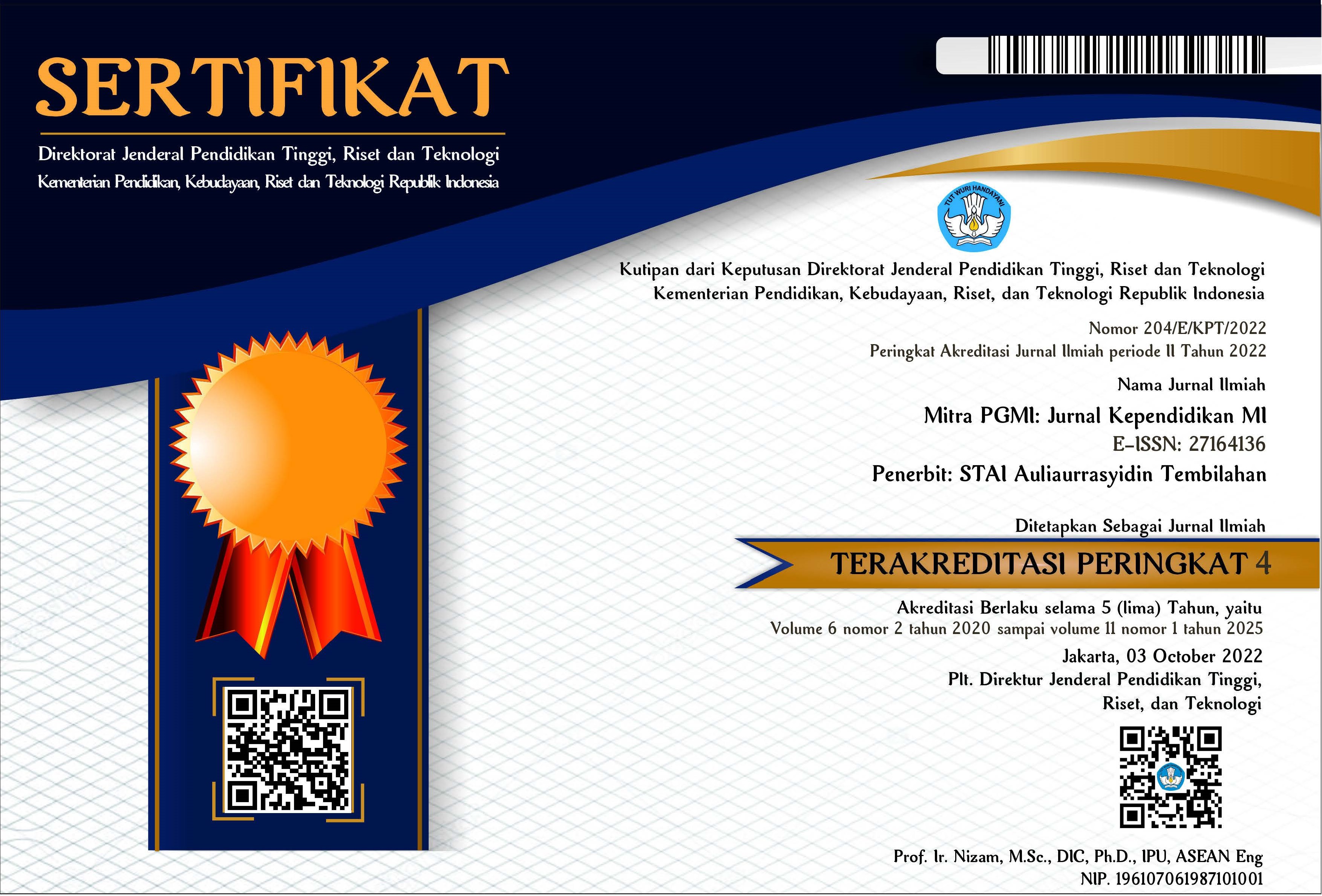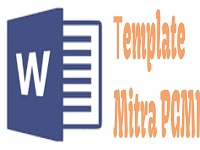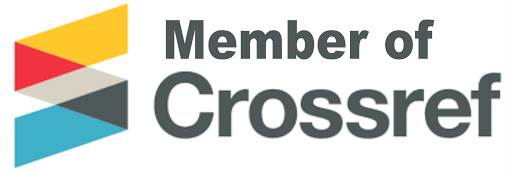The development of ethnoscience-based e-student worksheets to enhance Students scientific literacy at Madrasah Ibtidaiyah
DOI:
https://doi.org/10.46963/mpgmi.v11i1.2380Keywords:
Development, e-Student Worksheet, Ethnoscience, Scientific LiteracyAbstract
Science literacy is the ability to apply scientific knowledge in daily life, yet students' science literacy in Indonesia remains low. This study aims to develop ethnoscience-based electronic student worksheets (e-LKPD) and evaluate their feasibility, attractiveness, and effectiveness. The research uses the Research and Development (R&D) method with the ASSURE development model. The results show that the e-LKPD received validation from three experts: material experts (95.55%), design experts (91.66%), and learning practitioners (83.00%), all falling into the very valid category. The worksheets were found to be highly attractive, with a score of 85.21%. The N-Gain score was 0.79, indicating high effectiveness. The independent sample T-test revealed a significant difference in science literacy between the experimental and control classes (p = 0.001, less than 0.05). In conclusion, ethnoscience-based e-LKPD effectively enhances students' science literacy, as shown by the improvement from pretest to posttest results.
Downloads
References
Adhari, Sulistri, E., & Utama, E. G. (2024). Pengaruh Model Pembelajaran CLIS Berbasis Outdoor StudyTerhadap Kemampuan Literasi Sains Siswa Kelas V Sekolah Dasar. Pendas: Jurnal Ilmiah Pendidikan Dasar, 9(4), 77–91.
Almeida, B., Santos, M., & Justi, R. (2023). Aspects and Abilities of Science Literacy in the Context of Nature of Science Teaching. Science and Education, 32(3), 567–587. https://doi.org/10.1007/s11191-022-00324-4.
Atmojo, S. E., & Kurniawati, W. (2018). Thematic Learning Model of Science, Environment, Technology and society in Improving Elementary Students’ Science Literacy. JPI, 7(1), 60–69. https://doi.org/10.23887/jpi-undiksha.v7i1.12099.
Azmy, B., & Juniarso, T. (2020). Instrumen Literasi Sains Dalam Pembelajaran Ilmu Pengetahuan Alam Di Sekolah Dasar. Malih Peddas (Majalah Ilmiah Pendidikan Dasar), 10(1), 1–10. https://doi.org/10.26877/malihpeddas.v10i1.6097.
Bossér, U. (2024). Transformation of School Science Practices to Promote Functional Scientific Literacy. Research in Science Education, 54(2), 265–281. https://doi.org/10.1007/s11165-023-10138-1.
Cahya, T. R. T. W., Amita Tri Prasasti, P., & Kusumawati, N. (2022). Pengembangan Bahan Ajar E-Book Berbasis STEM dalam Peningkatan Kemampuan Literasi Sains di Sekolah Dasar. Jurnal Ilmiah Ilmu Pendidikan, 5(9), 3469–3474. http://Jiip.stkipyapisdompu.ac.id.
Chen, J., Zhang, Y., Wei, Y., & Hu, J. (2021). Discrimination of the Contextual Features of Top Performers in Scientific Literacy Using a Machine Learning Approach. Research in Science Education, 51, 129–158. https://doi.org/10.1007/s11165-019-9835-y.
Doshi, A., Weinert, S., & Attig, M. (2024). Self-Regulatory Abilities as Predictors of Scientific Literacy Among Children in Preschool and Primary School Years. Learning and Individual Differences, 114. https://doi.org/10.1016/j.lindif.2024.102515.
Elvianasti, M., Lestari, N. H., Meitiyani, M., & Maesaroh, M. (2023). Ethnoscience Integrated Flipbook Learning Media on Living Things Classification Materials. Journal of Innovation in Educational and Cultural Research, 4(4), 562–572. https://doi.org/10.46843/jiecr.v4i3.575.
Fuadi, H., Robbia, A. Z., Jamaluddin, & Jufri, A. W. (2020). Analisis Faktor Penyebab Rendahnya Kemampuan Literasi Sains Peserta Didik. Jurnal Ilmiah Profesi Pendidikan, 5(2), 108–116. https://doi.org/10.29303/jipp.v5i2.122.
Herianingtyas, N. L. R. (2022). Penguatan Literasi Sains Siswa MI/SD Melalui Pengembangan E-Modul dengan Instrumen Asesmen Berbasis Higher Order Thingking Skills. 2(1), 15–26. https://doi.org/10.15408/elementar.v2i1.28.
Jufrida, Kurniawan, W., & Basuki, F. R. (2024). Ethnoscience Learning: How Do Teacher Implementing to Increase Scientific Literacy in Junior High School. International Journal of Evaluation and Research in Education, 13(3), 1719–1730. https://doi.org/10.11591/ijere.v13i3.26180.
Jumiati, S. (2023). Implementasi Pembelajaran Etnosains Terintegrasi Ke Dalam Pelajaran IPA Materi Keanekaragaman Hayati dan Energi Terbarukan Di MAN Paser. Academia: Jurnal Inovasi Riset Akademik, 3(1), 74–80.
Kamal, F. A., Subali, B., Astuti, B., Rusilowati, A., & Widiyatmoko, A. (2024). Development of STEM-Based Digital Student Worksheet to Improve Students’ Numeracy and Science Literacy. Jurnal Penelitian Pendidikan IPA, 10(5), 2454–2464. https://doi.org/10.29303/jppipa.v10i5.6689.
Kintan Limiansih, Niluh Sulistyani, & Margaretha Madha Melissa. (2024). Persepsi Guru SMP terhadap Literasi Sains dan Implikasinya pada Pembelajaran Sains di Sekolah. Jurnal Pendidikan MIPA, 14(3), 786–796. https://doi.org/10.37630/jpm.v14i3.1858.
Lestari, L., & Nabila, N. (2024). Penerapan Etnosains dalam Pembelajaran Ilmu Pengetahuan Alam dan Sosial Kelas IV di MI As-Sunni Pamekasan. Al-Madrasah Jurnal Pendidikan Madrasah Ibtidaiyah, 8(2), 675. https://doi.org/10.35931/am.v8i2.3461.
Listiani, D. N., & Rosita, F. Y. (2022). Pendampingan Hadroh Al-Banjari Untuk Meningkatkan Semangat Berselawat Pada Masa Pandemi. Ngarsa: Journal of Dedication Based on Local Wisdom, 2(1), 57–68. https://doi.org/10.35719/ngarsa.v2i1.271.
Nuro, F. R. M., Suwandayani, B. I., & Majid, I. N. (2020). Penerapan Literasi Sains di Kelas IV Sekolah Dasar. Jurnal Pemikiran Dan Pengembangan Sekolah Dasar (JP2SD), 8(2), 179–187. https://doi.org/10.22219/jp2sd.v8i2.15189.
Oliver, M. C., & Adkins, M. J. (2020). “Hot-headed” Students? Scientific Literacy, Perceptions and Awareness of Climate Change in 15-Year Olds Across 54 Countries. Energy Research and Social Science, 70. https://doi.org/10.1016/j.erss.2020.101641.
Permatasari, P. (2021). Pengembangan Media Pembelajaran Videoscribe Berbasis Android untuk Meningkatkan Hasil Belajar Siswa Pada Pembelajaran Tematik Kelas IV Semester Ganjil di SD Islam As-Salam Malang. Universitas Islam Negeri Maulana Malik Ibrahim Malang.
Pertiwi, W. J., Solfarina, & Langitasari, I. (2021). Pengembangan Lembar Kerja Peserta Didik (LKPD) Berbasis Etnosains Pada Konsep Larutan Elektrolit dan Nonelektrolit. Jurnal Inovasi Pendidikan Kimia, 15(1), 2717–2730.
Pranata, A. (2022). Pendidikan Model Pembelajaran Berbasis Kearifan Lokal di Entikong Perbatasan Kalimantan Barat. Jurnal Pendidikan: Riset & Konseptual, 4(4), 548–552.
Puspita, D. A. D. Dela, Fauziah, H., Khaerunisah, Hikmawati, Sihotang, H. K. B., & Rokhmat, J. (2022). Identifikasi Etnosains Yang Memiliki Potensi Untuk Diintegrasikan Dalam Pembelajaran IPA. Jurnal Penelitian Dan Pembelajaran Fisika Indonesia, 4(2), 1–7. https://doi.org/10.29303/jppfi.v4i2.188.
Putri, D. A. H., Asrizal, & Usmeldi. (2022). Pengaruh Integrasi Etnosains Dalam Pembelajaran Sains Terhadap Hasil Belajar: Meta Analisis. Orbita: Jurnal Hasil Kajian, Inovasi, Dan Aplikasi Pendidikan Fisika, 8(1), 103–108.
Restiani, N. L. D., Margunayasa, I. G., & Paramita, M. V. A. (2024). Improving Scientific Literacy of Elementary School Students through Problem-Based Learning Model with Balinese Local Wisdom. Jurnal Ilmiah Sekolah Dasar, 7(4), 590–598. https://doi.org/10.23887/jisd.v7i4.62080.
Risal, Z., Hakim, R., & Abdullah, A. R. (2022). Metode Penelitian Pengembangan Research and Development (R&D) Konsep, Teori-Teori dan Desain Penelitian. CV. Literasi Nusantara Abadi.
Rusmansyah, Leny, & Sofia, H. N. (2023). Improving Students’ Scientific Literacy and Cognitive Learning Outcomes through Ethnoscience-Based PjBL Model. Journal of Innovation in Educational and Cultural Research, 4(1), 1–9. https://doi.org/10.46843/jiecr.v4i1.382.
Senjaya, A. J. (2020). Langkah-Langkah Analisis Statistik dalam Riset Bidang Pendidikan dan Sosial. K-Media.
Sesanti, N. R., Wahyuningtyas, D. T., Id, N. A., & Id, D. A. (2022). Inovasi E-Modul Berbasis Literasi Sains Dan Numerasi. Dedikasi Nusantara: Jurnal Pengabdian Masyarakat Pendidikan Dasar, 2(2), 107–119. https://ojs.unpkediri.ac.id/index.php.dedikasi.
Sidiq, A. P., Maslani, M., Abdi, A. S., & NUralim, D. (2024). Pengembangan Bahan Ajar Media Non Cetak. EDUKATIF : JURNAL ILMU PENDIDIKAN, 6(4), 3621–3628. https://doi.org/10.31004/edukatif.v6i4.7218.
Suparya, I. K., I Wayan Suastra, & Putu Arnyana, I. B. (2022). Rendahnya Literasi Sains: Faktor Penyebab dan Alternatif Solusinya. Jurnal Ilmiah Pendidikan Citra Bakti, 9(1), 153–166. https://doi.org/10.38048/jipcb.v9i1.580.
Suryaningsih, S., & Nurlita, R. (2021). Pentingnya Lembar Kerja Peserta Didik Elektronik (E-LKPD) Inovatif dalam Proses Pembelajaran Abad 21. Jurnal Pendidikan Indonesia, 2(7), 1256–1268. https://doi.org/10.36418/japendi.v2i7.233.
Suryanti, Mariana, N., Yermiandhoko, Y., & Widodo, W. (2020). Local Wisdom-Based Teaching Material For Enhancing Primary Students’ Scientific Literacy Skill. Jurnal Prima Edukasia, 8(1), 96–105. https://doi.org/10.21831/jpe.v8i1.32898.
Techakosit, S., & Wannapiroon, P. (2015). Connectivism Learning Environment in Augmented Reality Science Laboratory to Enhance Scientific Literacy. Procedia - Social and Behavioral Sciences, 174, 2108–2115. https://doi.org/10.1016/j.sbspro.2015.02.009.
Thala’at, M., Mulyadi Permana, W., & Istifi’iyati, N. (2022). Analisis Implementasi Model Pembelajaran Berbasis Etnosains Dalam Pembelajaran Tematik Di Madrasah Ibtidaiyah. Al-Mujahidah: Jurnal Pendidikan Guru Madrasah Ibtidaiyah, 3(1), 314–322.
Wulan Junita, I., & Yuliani. (2022). Pengembangan e-LKPD Berbasis Etnosains Untuk Melatihkan Keterampilan Literasi Sains Pada Materi Transpor Membran. Tahun, 11(2), 356–367. https://ejournal.unesa.ac.id/index.php/bioedu.
Yasa, I. M. W., Budi Wijaya, I. K. W., Indrawan, I. P. O., Muliani, N. M., & Darmayanti, N. W. S. (2022). The Implementation Profile of The Science Literacy Movement in Elementary Schools. Jurnal Ilmiah Sekolah Dasar, 6(2), 319–330. https://doi.org/10.23887/jisd.v6i2.45174.
Downloads
Published
Issue
Section
License
Copyright (c) 2025 Rivaldi Wiratama, Eko Budi Minarno, M. Fahim Tharaba

This work is licensed under a Creative Commons Attribution-ShareAlike 4.0 International License.
Authors who publish with this journal agree to the following terms:
1. Copyright on any article is retained by the author(s).
2. The author grants the journal, right of first publication with the work simultaneously licensed under a Creative Commons Attribution shareAlike 4.0 International License that allows others to share the work with an acknowledgment of the work’s authorship and initial publication in this journal.
3. Authors are able to enter into separate, additional contractual arrangements for the non-exclusive distribution of the journal’s published version of the work (e.g., post it to an institutional repository or publish it in a book), with an acknowledgment of its initial publication in this journal.
4. Authors are permitted and encouraged to post their work online (e.g., in institutional repositories or on their website) prior to and during the submission process, as it can lead to productive exchanges, as well as earlier and greater citation of published work.
5. The article and any associated published material is distributed under the Creative Commons Attribution-ShareAlike 4.0 International License








2.png)


